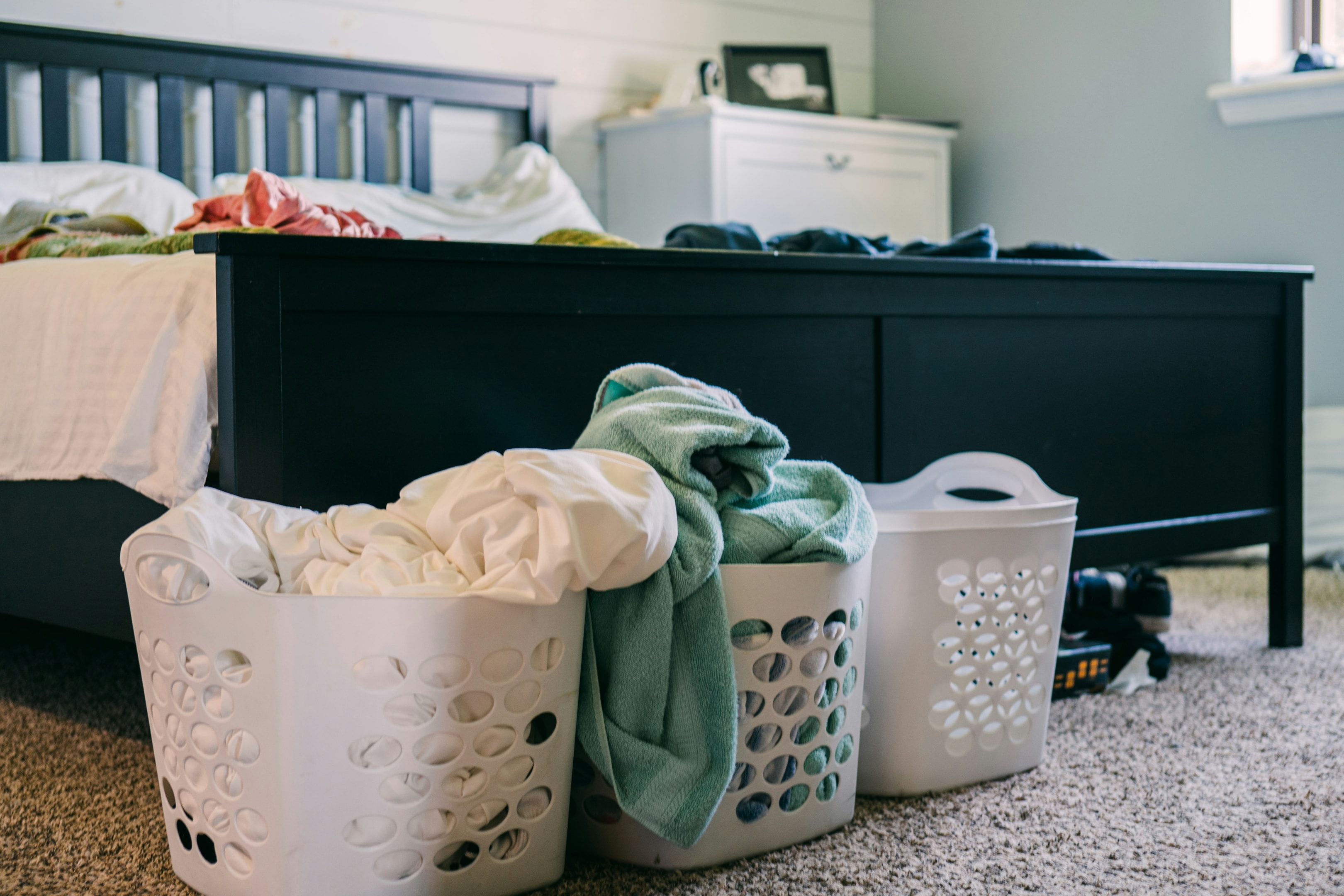Whether you’re moving into a smaller house, transitioning to a new space, or just realizing you’ve collected way too much stuff, the downsizing process can feel overwhelming. But here’s the truth, downsizing isn’t just about losing square footage. It’s about creating breathing room, saving time and money, and making your new home more intentional from the start.
To make your move less stressful, be sure to plan ahead by starting your decluttering and organizing process early.
In this blog, we’ll walk you through how to downsize before a move, with tips for decluttering and organizing every part of your current home. From closet space to kitchen gadgets, we’ll help you with deciding what to keep and what to let go, so you can let go of what no longer serves you and keep what truly matters.
Introduction to Decluttering
Decluttering is the foundation of any successful downsizing process. It’s your chance to take stock of your belongings, clear out unwanted items, and make room for what truly matters in your new home. Tackling paper clutter, old clothes, and unused gadgets not only helps you maximize space but also makes the move less stressful. Start the decluttering process early and create a plan that breaks the task into manageable steps. If you’re feeling overwhelmed, consider bringing in a professional organizer, they can offer practical tips and strategies to help you decide what to keep, donate, or discard. With the right approach, you’ll transform cluttered spaces into organized, welcoming rooms, setting the stage for a fresh start in your new home.
Why Downsizing Is Worth It
Let’s be honest: how much stuff do we actually use? A move is the perfect chance to take inventory, cut clutter, and start fresh.
By downsizing before you pack, you’ll:
- Save money on moving costs (fewer boxes = smaller truck = lower price)
- Maximize space in your new home
- Avoid bringing unnecessary items into a smaller space
- Reduce stress during the packing and unpacking process
Once you’ve downsized, the moving process becomes easier and more efficient, making it simpler to organize your new space. And if you need extra time to decide what stays or goes, temporary storage, including the option to rent storage units for added flexibility during your transition, is always an option.

Assessing Your New Space
Before you start decluttering, take time to assess your new space so you know exactly how much stuff you can bring. Measure the square footage, check out the closet space, and evaluate all available storage spaces. Review the floor plan to see how your current belongings will fit comfortably, and think about where you might need storage solutions to maximize space. This step will help you decide what to keep and what to let go of, making the downsizing process smoother and more intentional. By understanding your new space, you’ll avoid overcrowding and ensure that everything you bring has a place and a purpose.
1. Start Early and Schedule Time
Give yourself enough time to work through your home room by room. Downsizing isn’t a last-minute task, it’s a process. Aim to start early, ideally a few weeks before your move.
Break it into manageable tasks:
- Schedule time each day or week to focus on one area
- Start with one room (like the guest room, storage closet, or garage)
- Use bins or boxes to sort into: Keep, Sell, Donate, Store, and Toss
2. Sort by Function and Frequency
If you haven’t used it in a year, chances are you won’t miss it. Use these questions to guide the decluttering process:
- Does this serve a purpose in my current life?
- Does it have sentimental value or is it just habit to keep it?
- Will it fit into the floor plan of my new house?
- Do I have duplicate items that I don’t need?
- Have I checked the expiration dates on pantry goods, medications, and other perishable items?
This step is especially useful for:
- Kitchen gadgets
- Office supplies
- Bulky furniture that won’t fit comfortably in your new space
3. Digitize and Minimize Paper Clutter
Paper clutter builds up fast, and moving is a great time to get it under control.
- Digitize documents and photos by scanning important files, then save them to an external hard drive or secure cloud account to declutter and protect them
- Recycle old files, expired warranties, and physical copies you no longer need
- Shred anything sensitive before discarding
This frees up storage space and keeps you organized in your new home.
4. Let Go of Sentimental Items (Gently)
We all have keepsakes, but when everything is a keepsake, it stops being special.
Here’s how to honor memories without drowning in sentimental items:
- Take photos of meaningful but bulky items
- Keep a small box for heirlooms and items that truly matter
- Gift certain items to family members who may cherish them more
Letting go doesn’t mean forgetting, it means creating space for new memories.
5. Sell, Donate, or Store What You Don’t Need Now
As you downsize, you’ll find things that still have value, but don’t belong in your new house.
- Host a garage sale or sell through Facebook Marketplace for some extra cash
- Donate unwanted items to local shelters or nonprofits
- Use a storage unit to store seasonal items, holiday decorations, or pieces you’re not ready to part with just yet
Storage solutions offer a flexible, cost-effective way to hold onto larger items without cluttering your living space.
Hosting a Garage Sale
A garage sale is a fantastic way to clear out unwanted items and earn some extra cash before your move. Start by gathering everything you no longer need and price items to sell quickly. Spread the word by advertising your garage sale on Facebook Marketplace, local community boards, and neighborhood groups. For even more success, consider teaming up with neighbors or friends to create a larger event that attracts more shoppers. After the sale, donate any remaining unwanted items to local shelters or charities, this way, you’ll declutter your home and help others at the same time.
Making Extra Cash
Downsizing is the perfect opportunity to make some extra cash that can help offset moving expenses or storage unit fees. List larger items, duplicate items, or kitchen gadgets you no longer use on platforms like Facebook Marketplace. Office supplies, furniture, and other belongings that have outlived their usefulness for you may be just what someone else is looking for. Selling items that no longer serve a purpose or have lost their sentimental value not only helps you declutter but also puts a little money back in your pocket, making the downsizing process even more rewarding.
6. Use Smart Storage Strategies to Save Space
Even if you’re downsizing into less space, there are ways to make every inch count.
- Use vacuum sealed bags for off-season clothing or bedding
- Label boxes by room and category so unpacking is a breeze
- Invest in multi-functional furniture for smaller homes with limited closet space
- Use under-bed or vertical storage spaces to maximize space
You can also consult a professional organizer if you’re feeling stuck, they specialize in helping people start decluttering and bring structure to the downsizing process. Professional organizers provide expert guidance and support, making the process more efficient and less emotional.

Optimizing Closet Space
Making the most of your closet space is key to keeping your new home organized and clutter-free. Start by sorting through your clothes and accessories, letting go of anything that doesn’t fit or hasn’t been worn in a while. Use vacuum sealed bags to store out-of-season clothing, freeing up valuable storage space for everyday items. Invest in storage solutions like plastic bins, shelves, and drawer organizers to keep everything tidy and accessible. Don’t forget to consider the needs of other family members, plan your closet space so everyone has enough room for their essentials. By optimizing your closet, you’ll create a more functional living space and make settling into your new home a breeze.
Key Takeaways
- Start early and tackle one room at a time to avoid burnout
- Ask honest questions to let go of unwanted items and make smarter choices
- Digitize important documents and reduce paper clutter
- Use temporary storage for sentimental items, overflow, or things you’re not ready to decide on
- Selling or donating before a move helps you save money, save space, and focus on a fresh start
Final Thoughts
Learning how to downsize before a move isn’t just about cutting back, it’s about creating clarity. These tips for decluttering and organizing will help you let go of the excess, protect what matters, and make room for what’s next.
Whether you’re moving into a smaller house or just want to take control of the decluttering process, Action Moving & Storage is here to support every step, from packing and planning to storage solutions and move-in day.
Ready to make your move stress-free and clutter-free? Get a free quote today and let our team help you move forward with confidence.